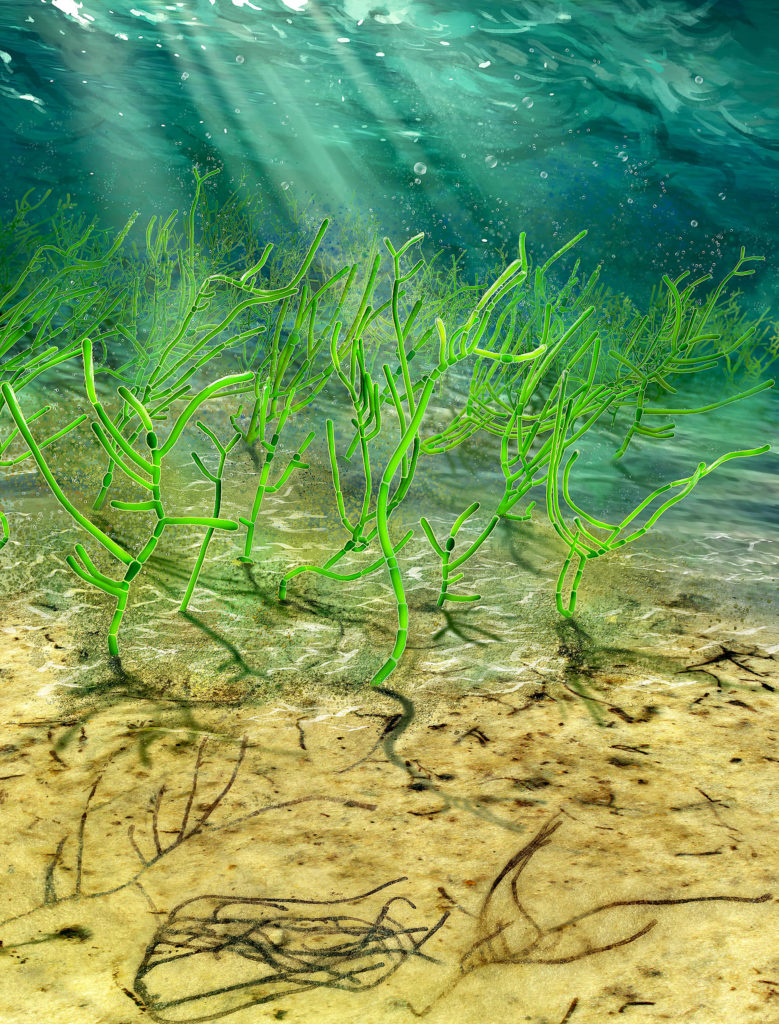Researchers at Virginia Tech report finding what may be a relative of today’s land plants ancestors — tiny green algae in modern China.

Image credits Shuhai Xiao, Qing Tang / Virginia Tech.
Scientists have recently discovered a new fossil species of green algae. These diminutive seaweeds belong to a species known as Proterocladus antiquus, and each individual measures 2 millimeters in length, making them around the size of a common flea. Currently, this represents the oldest species of green algae ever discovered.
The green chlorophyll inside their tissues strongly suggests that Proterocladus antiquus could be related to the oldest ancestors of all the plants currently dotting the Earth’s dry landmasses.
Plant, I am your father
“The entire biosphere is largely dependent on plants and algae for food and oxygen, yet land plants did not evolve until about 450 million years ago,” said Shuhai Xiao, co-lead author of the paper and a Professor at Virginia’s Department of Geosciences.
“Our study shows that green seaweeds evolved no later than 1 billion years ago, pushing back the record of green seaweeds by about 200 million years. What kind of seaweeds supplied food to the marine ecosystem?”
The microfossils were found in rocks recovered at a site near the city of Dalian, in the Liaoning Province of northern China, an area that used to be a shallow ocean. The discovery suggests that green seaweeds were an important player in global ecosystems long before plants took root on dry soil.
These tiny algae were first spotted by Qing Tang, a post-doctoral researcher at Virginia’s Department of Geosciences, using an electron microscope. He shared this with Xiao and the duo worked to improve the imagining of the algae, and to date and describe the species.

Image credits Shuhai Xiao, Qing Tang / Virginia Tech.
There are three groups of seaweed, brown (Phaeophyceae), green (Chlorophyta), and red (Rhodophyta) algae, each containing thousands of species. Red algae, the most common group today, are known to have existed from as far back as 1.047 billion years ago. Shuhai explains that land plants are believed to have evolved from green algae which moved and adapted to life on dry land. However, Xiao adds that not everyone is in agreement with this hypothesis.
“Not everyone agrees with us; some scientists think that green plants started in rivers and lakes, and then conquered the ocean and land later,” he says.
Red algae do photosynthesize, but they use up a different part of the light spectrum than green plants (namely the color blue, which penetrates water more easily). However, red algae use the pigment phycoerythrin to absorb blue light — making them appear red. This points to green seaweeds as a more likely ancestor for today’s plants. Furthermore, the team reports that “a group of modern green seaweeds, known as siphonocladaleans, are particularly similar in shape and size to the fossils we found.”
Today, plants underpin complex life on the planet by providing food and oxygen (through photosynthesis) for all animals. However, around 2 billion years ago, the Earth had no green plants at all in oceans, Xiao said.
“[Proterocladus antiquus displays] multiple branches, upright growths, and specialized cells known as akinetes that are very common in this type of fossil,” he adds. “Taken together, these features strongly suggest that the fossil is a green seaweed with complex multicellularity that is circa 1 billion years old. These likely represent the earliest fossil of green seaweeds. In short, our study tells us that the ubiquitous green plants we see today can be traced back to at least 1 billion years.”
According to Xiao and Tang, the tiny seaweeds once lived in a shallow ocean, died, and then became “cooked” beneath a thick pile of sediment, preserving the organic shapes of the seaweeds as fossils. Many millions of years later, the sediment was then lifted up out of the ocean and became the dry land where the fossils were retrieved by Xiao and his team, which included scientists from Nanjing Institute of Geology and Paleontology in China.
The paper has been published in the journal Nature Ecology & Evolution.






